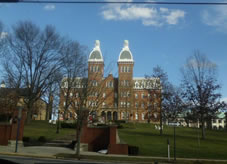
| Home | Washington County Courthouse | George Washington Hotel | South Main Street Train Station | Washington & Jefferson College |

Washington & Jefferson College
Washington and Jefferson College is a liberal arts college in Washington Pa. It is also known as W&J college or even just W&J.
Washington & Jefferson College traces its origin to three log cabin colleges established by three frontier clergymen in the 1780s. Eventually there were only two colleges, Jefferson college, and Washington college.
Around the end of the civil war, neither college had many students and finally decided to unify and make Washington & Jefferson college.
George P. Hays, who had assumed the presidency amid the court battle and the unification controversy, led the newly unified college until 1881. His successor, James D. Moffat, led the college through a period of growth where the college constructed the Old Gym, Hays Hall, Thompson Memorial Library, and Thistle Physics Building, as well as purchasing the land known as the "old fair ground," now used for Cameron Stadium. Towards the end of his term, Moffat personally paid for the 1912 renovations of McMillan Hall.
In 1914, Frederick W. Hinitt was elected president. His tenure was dominated by the United States' entry into World War I, with an enrollment drop of 50%.
William E. Slemmons, a college trustee and adjunct professor, succeeded Hinitt and served as interim president from May 1918 to June 1919. After the war ended in 1919, Samuel Charles Black took over and helped to stabilize the enrollment. While on a honeymoon tour of national parks, Black became ill and died.
His successor, Simon Strousse Baker, was well liked by the college's trustees and by "many a townsman," but the student body felt that Baker was "autocratic" and held an "unfriendly attitude toward the student body as individuals."Baker defended himself, saying that the perceived ill-will towards students was unintentional and a misunderstanding. Nonetheless, the student body held a strike and general walkout in 1931, prompting Baker to resign.
Washington & Jefferson is ranked #92 of all liberal arts colleges in the nation, placing it within "Tier 1" In Forbes Magazine's List of America's Best Colleges for 2010.
When it comes to sports, W&J is very successful too. They compete in 23 intercollegiate athletics at the National Collegiate Athletic Association (NCAA) Division III level. As of the 2009–10 academic year, the Presidents have won more than 108 Presidents' Athletic Conference (PAC) championships, 40 students were selected as conference Most Valuable Player, more than 300 athletes were awarded First Team All-Conference recognition, 75 received All-American honors, and 25 achieved Academic All-American status. During the 2005–2006 season, 34 percent of the student body played varsity-level athletics.
The football team has also been very successful, winning 18 out of the last 21 PAC Championships and advancing to the NCAA Division III playoffs 17 times. W&J played to a 0–0 tie in the 1922 Rose Bowl against the California Golden Bears. The men's ice hockey team won the 2008 College Hockey Mid America Conference championship, a Division I regional league of the American Collegiate Hockey Association.
W&J also fields teams in field hockey, wrestling, baseball, softball, and volleyball, as well as men's and women's cross country running, soccer, tennis, water polo, and basketball.